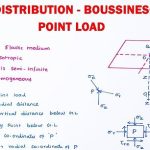Apart from the difficulty that the state of stress is not completely given in a shear test, the direct shear test suffers from the disadvantage that the deformation is strongly inhomogeneous, because the deformations are concentrated in a zone in the center of the shear box. An improved shear box has been developed by Roscoe in Cambridge (England), in which the deformation is practically homogeneous. The apparatus has been constructed with rotating side walls, so that a uniform shear deformation can be imposed on the sample, see Figure 22.4. This is denoted

as the simple shear apparatus. As in the direct shear box, the cross section in the horizontal plane is rectangular. The improvement is that the hinges at the top and the bottom of the side walls enable a uniform shear deformation of the sample. In Norway a variant of this apparatus has been developed, with a circular cross section. A uniform deformation is ensured by constructing the box using a system of stiff metal rings, that can be moved over each other. Although the simple shear test is a definite improvement with respect to the direct shear test, because the deformations are much more homogeneous, it is still not certain that sliding will occur only along horizontal planes. This would be the case only if the state of stress on a horizontal plane would become critical first, which would require that the horizontal stress is larger than the vertical stress. It is doubtful whether this will always be the case. When preparing the sample for testing it seems more likely that the horizontal stress is smaller than the vertical stress, so that it is to be expected that failure will occur by sliding along vertical planes, with a simultaneous rotation.
It may be interesting to investigate the influence of the toppling book row mechanism on the critical stresses, see Figure 22.2. Because in this case the stress combination on a vertical plane is critical, it follows from the Mohr circle that


This value is smaller than the one following from equation (22.1). It seems reasonable to assume that the soil will fail according to the weakest mechanism, so that equation (22.2) applies. This means that in a test with a small horizontal stress the critical shear stress is smaller than in a test with a high horizontal stress. If the test result in a test with a small horizontal stress is interpreted in the trdaitional manner, using eq. (22.1), this leads to a value of φ that is smaller than the true value. This explains why the strength determined in a shear test is often lower than the strength in a triaxial test.
In the two failure mechanisms considered the horizontal stress is the basic difference, and this suggests that the occurrence of one or the other mechanism (the toppling book row, or the sliding planks) will depend upon the relative magnitude of the horizontal stress in the test. This horizontal stress depends upon the material properties, but also on the method of installation of the sample. In general it is very difficult to say what the magnitude of the horizontal stress in a shear box is. This uncertainty in the state of stress is a disadvantage of the shear test, especially when compared to the triaxial test, in which the stresses in the three coordinate directions are well known.
It may be concluded that the shear test is not very well suited for an accurate determination of the shear strength parameters of a soil, because the state of stress is not fully known. The scatter in the results, and the relatively low values that are sometimes obtained, may well be a result of the unknown horizontal stress. The triaxial test does not suffer from this defect, as in this test the horizontal stress and the vertical stress can both be measured accurately. It may be mentioned that in soil mechanics pratice laboratory tests can sometimes be considered as scale tests of the behvaiour in the field. The oedometer test can be considered as such, when the initial stresses and the incremental stresses are taken equal to those in the field. For the problem of the shearing resistance of a large concrete offshore caisson, loaded by wave forces on the caisson, a shear test may be used if the vertical normal stress and the shear stress on the sample simulate the stresses to be expected in the field, and the sample has been carefully taken from the field to the shear box. Possible errors or inaccuracies may have the same effect in the laboratory and in the field, so that they do not invalidate the applicability of the test. But in this case it is also important to ensure that the horizontal stress in the sample is of the same order of magnitude as the horizontal stress in the field.


